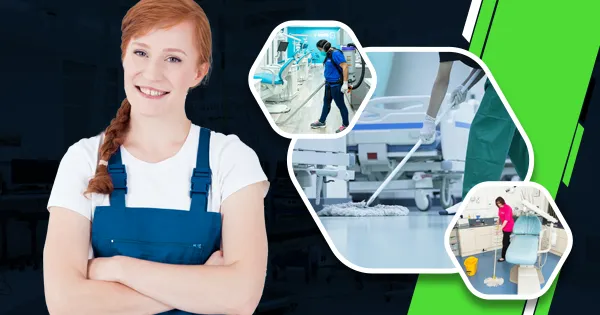Commercial cleaning in healthcare facilities is crucial to maintain a secure and hygienic atmosphere. To prevent Health Care-Associated Infections (HAIs) and guarantee regulatory compliance, strict processes are in place. Beyond controlling infections, cleanliness promotes patient safety, healing, and a satisfying medical experience. It lessens the possibility of infection and illnesses. A clean environment also improves the well-being and productivity of healthcare staff. It strengthens the institution’s reputation by highlighting its dedication to providing high-quality care.
Patient’s well-being by commercial cleaning procedures in Healthcare Facilities
Using thorough and efficient cleaning procedures in healthcare institutions is essential to improving patients’ experiences with commercial cleaning. This method improves patient satisfaction, safety, and well-being. The following are important details on how commercial cleaning can enhance the medical experience for patients:
- Infection Prevention: Commercial cleaning procedures contribute to a safer environment for patients by reducing the spread of illnesses. Lowering the chance of infection improves health outcomes and keeps patient care interruptions to a minimum.
- Clean and Comfortable Environments: Patients have a more comfortable and enjoyable experience in clean, hygienic facilities. Well-maintained common areas, waiting rooms, and patient rooms promote wellbeing and aid in the healing process.
- Improved Patient’s Satisfaction: When patients trust that the facility is clean and well-maintained, they are more likely to report satisfaction with their experience receiving healthcare. Positive patient experiences are linked to higher levels of patient satisfaction and potentially better outcomes.
- Consultation with Healthcare Professionals: Effective communication and collaboration between commercial cleaning staff and healthcare professionals contribute to a cohesive and patient-centered approach. Working together guarantees that cleaning procedures support the overall goals and patient care priorities of the healthcare facility.
Measures to Control Infection in Healthcare Facilities
In order to maintain a clean and healthy workplace, infection control procedures and commercial cleaning techniques are closely related in healthcare institutions. The following are some particular infection control strategies that support commercial cleaning in healthcare environments:
- Use of Approved Disinfectant: The Environmental Protection Agency (EPA) has approved some disinfectants for use in hospital settings; be sure you choose and utilize them. Make sure that the cleaning crew has received training on how to apply disinfectants correctly and when to contact them.
- Proper Waste Management: Ensure proper disposal of infectious waste, such as used cleaning supplies. Train employees who handle garbage during cleaning procedures on proper disposal and handling techniques.
- Employment of Technology: To increase the quality of cleaning procedures, explore and apply advanced cleaning technologies including electrostatic sprayers and ultraviolet (UV) disinfection. Keep up with developments that can increase coverage and efficiency.
- Hand Hygiene: Healthcare institutions provide a strong defense against diseases by actively practicing frequent handwashing and creating a culture of cleanliness through teaching. This enhances everyone’s safety and well-being within the facility.
Specialised Cleaning for Different Areas
Cleaning procedures are customized to meet the special needs and issues that each location in a facility presents in order to provide specialized cleaning for those areas. Using this method guarantees that every area gets the targeted care it requires for the highest levels of safety and cleanliness.
- Patient’s Rooms: Using specialized, effective cleaning agents ensures a clean and comfortable environment. Commercial cleaning in patient rooms not only addresses infection control but also contributes to patient well-being and satisfaction.
- Operating Rooms: Thorough cleaning procedures guarantee the absence of microorganisms in the operating room. A coordinated cleaning plan is essential for patient safety and smooth surgical procedures.
- Restrooms: A comprehensive and frequent cleaning of fixtures and surfaces is part of a hygiene-focused commercial cleaning approach. To get rid of germs and provide a clean, safe environment, specialized cleaning chemicals are utilized. Maintaining cleanliness raises the bar for hygiene.
- Common Areas and Waiting Rooms: Commercial cleaning places a strong priority on cleaning high-traffic areas often, particularly on seating surfaces, in common areas and in waiting rooms. The plan also calls for adding relaxing lighting or air purifiers to improve the overall environment and give people a healthy, secure, and comfortable space.
Conclusion
To avoid infections, ensure compliance, and provide a secure, high-quality care environment, commercial cleaning is essential in the healthcare industry. It strengthens the institution’s dedication to excellence by improving patient safety and satisfaction while also benefiting healthcare staff members’ well-being and productivity.











